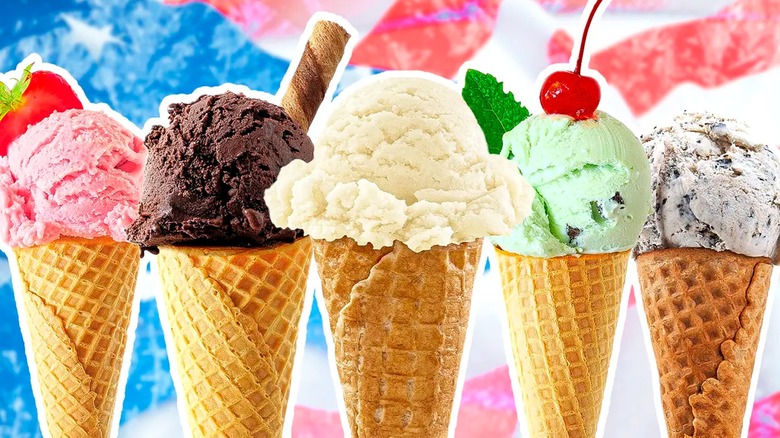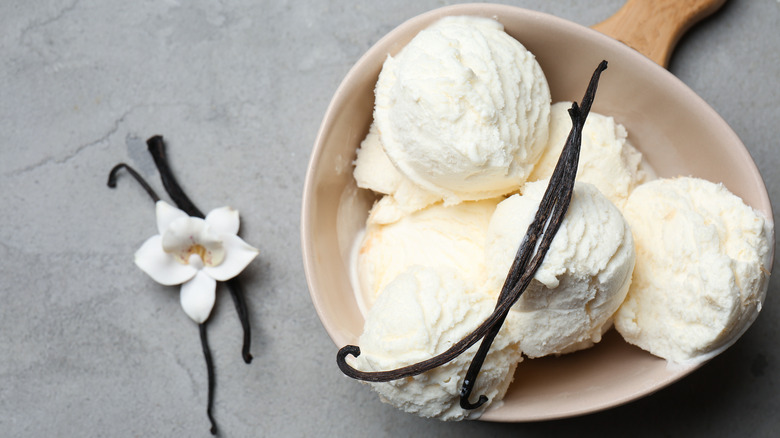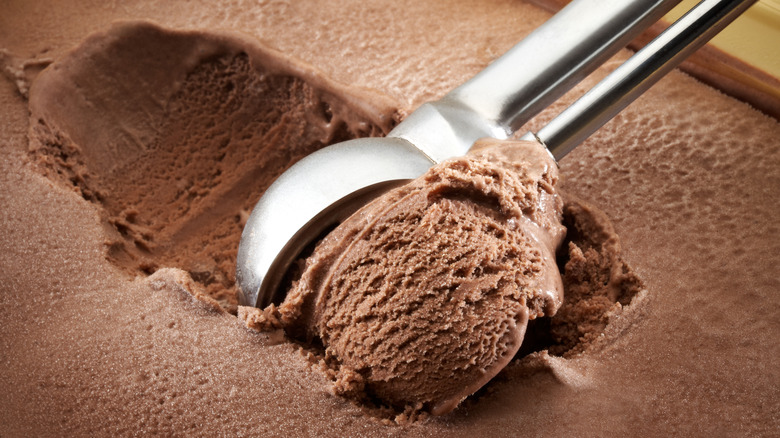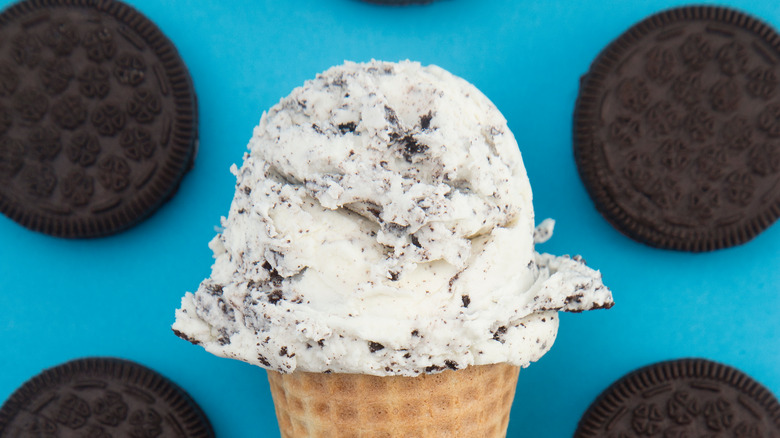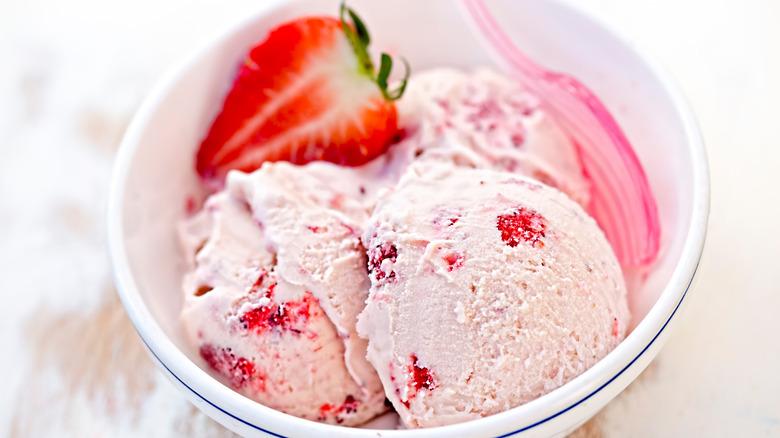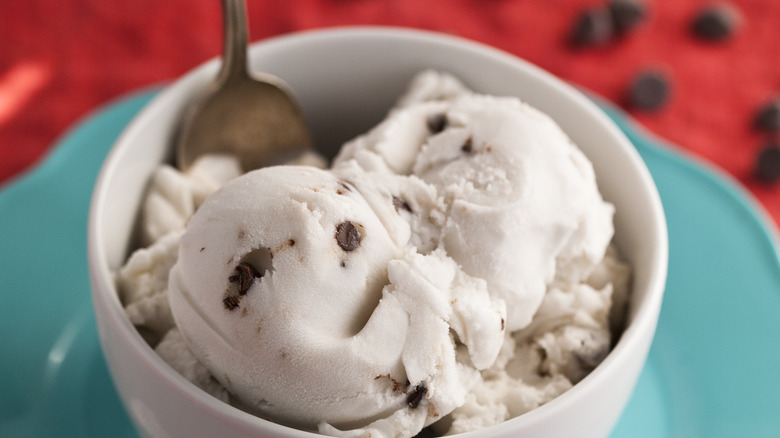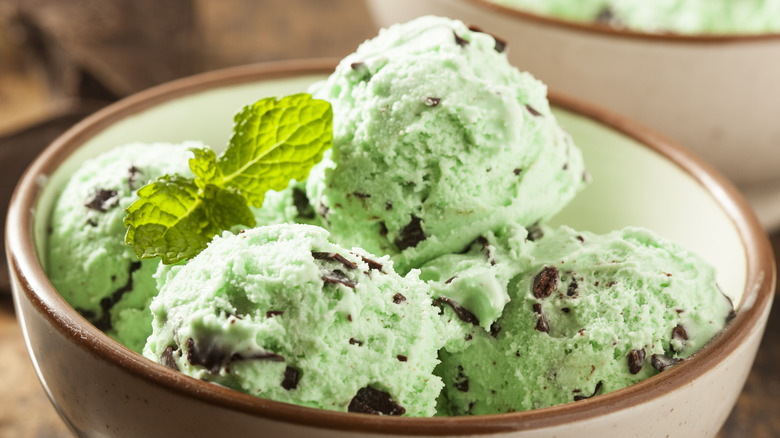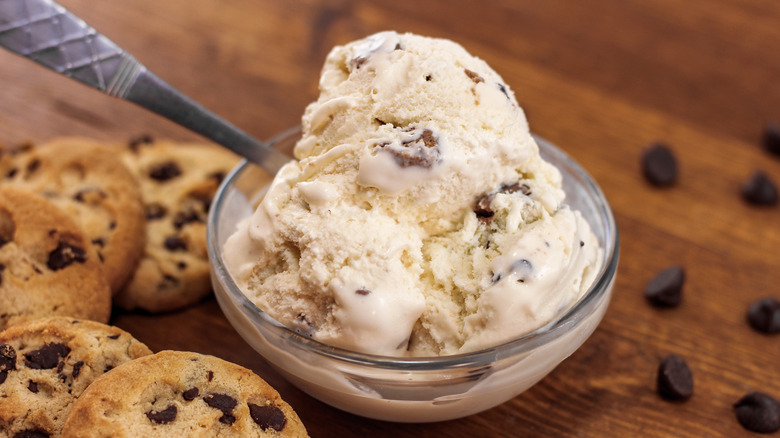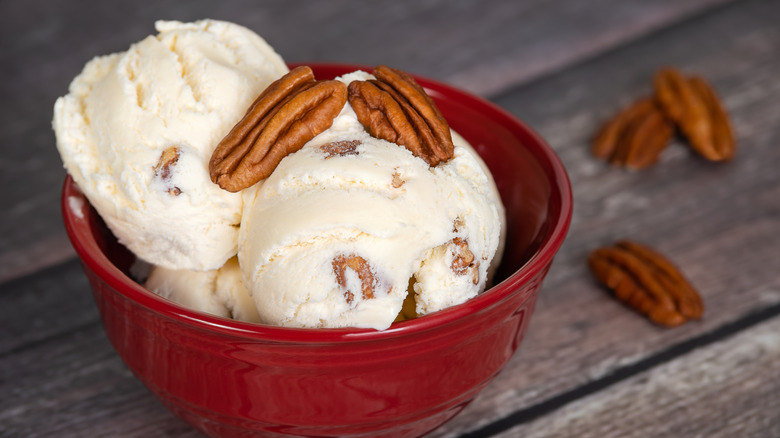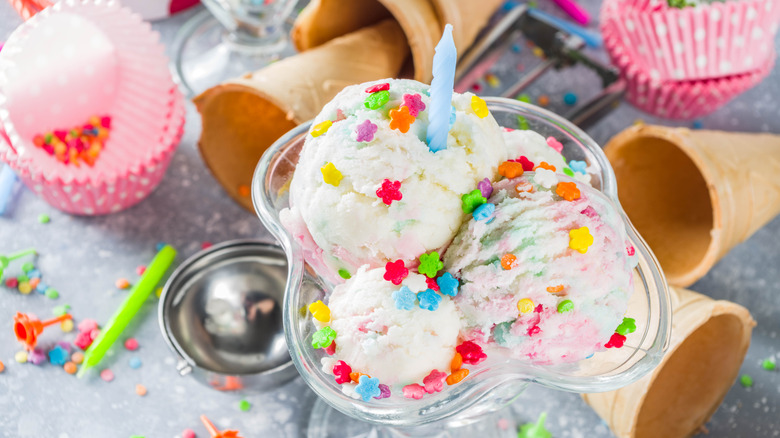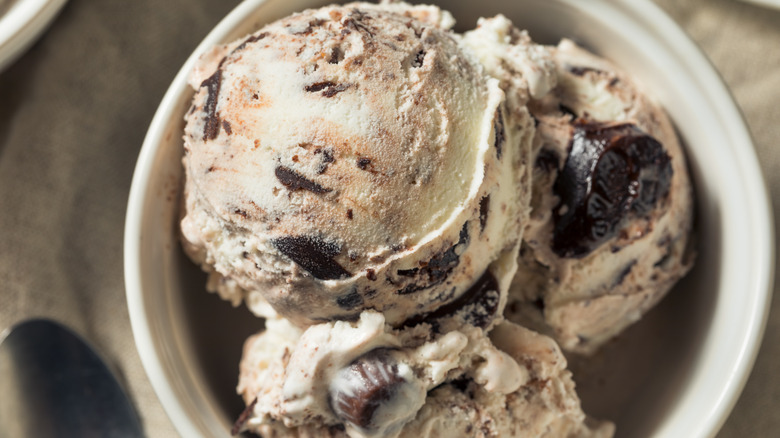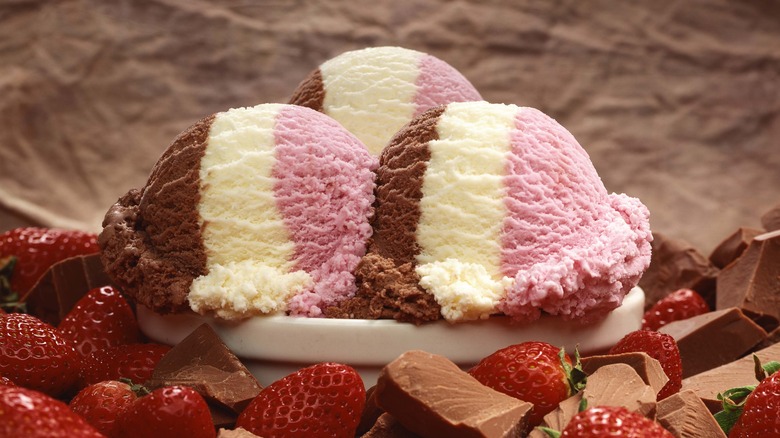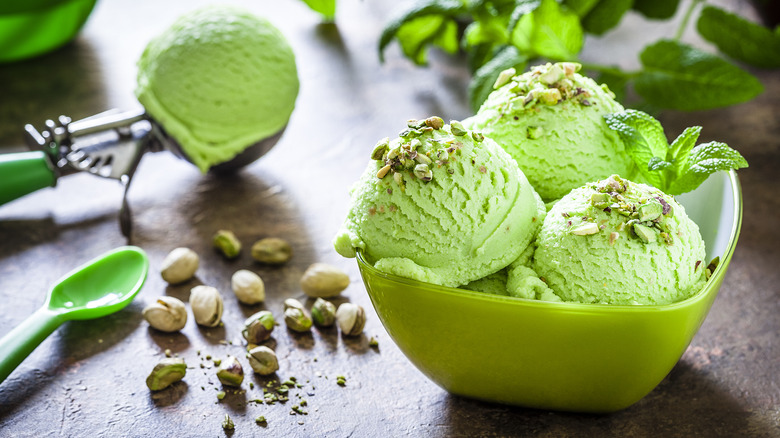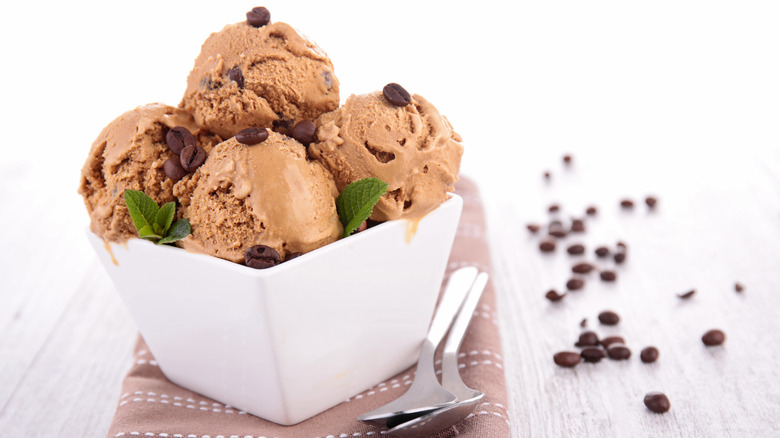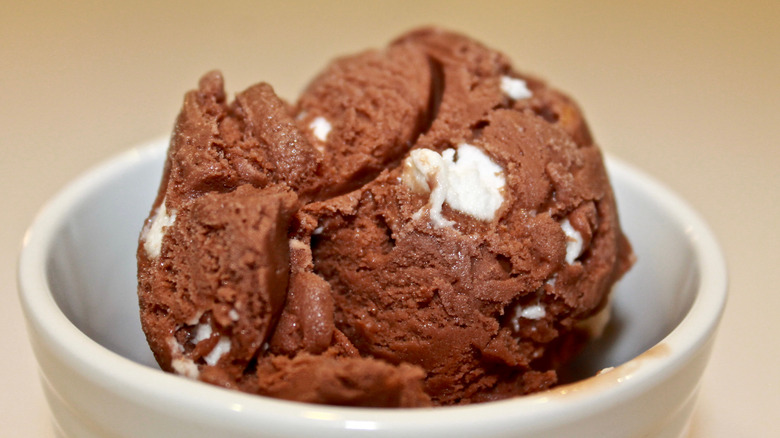14 Most Popular Ice Cream Flavors In The US And Where They Came From
Ice cream is one of the tastiest ways of cooling off on a sweltering summer day. And it's so popular in the United States that July was made National Ice Cream Month. According to The National Frozen and Refrigerated Foods Association, Americans eat more ice cream than any other country, with an average of 48 pints per person per year.
Americans have a long history with ice cream. Both George Washington and Thomas Jefferson were big fans. Both former presidents had ice houses built at their respective plantation homes, Mount Vernon and Monticello, so they could enjoy what was, at the time, quite the delicacy. While they had access to many flavors 200-plus years ago, there were not nearly as many as we have today.
This is not an exhaustive list of popular ice cream flavors across the U.S., so please don't be offended if your favorite scoop isn't on it. We have, however, gathered together a list of the top 14 most popular flavors in the U.S., each of which has a history as unique as the flavor itself.
1. Vanilla
Starting with vanilla may disappoint you. Vanilla ice cream is just so vanilla! But we promise that there is nothing bland or ordinary about this flavor's history. The second most expensive spice on earth, vanilla comes from the most widely farmed variety of orchid, the vanilla bean orchid. One kilogram (a little over two pounds) of vanilla beans can sell for between $600 and $700, which hardly makes it boring.
The first major producers of vanilla were the Totonac, one of Mexico's indigenous people, who used it for medicine rather than as just a flavoring. Mayan people may have used vanilla in beverages made from cacao, and the Aztecs definitely used vanilla in xocolatl, better known as hot chocolate today.
Spanish conquistadors brought vanilla back with them to Europe, where it became popular among royalty and other elites and was used, among other things, as an aphrodisiac. Thomas Jefferson encountered vanilla ice cream during his time in France, and it became a regular feature in his household ever since. A recipe for vanilla ice cream in Jefferson's own handwriting still exists. Copies exist online if you want to try making it for yourself.
2. Chocolate
As you might have gleaned from the history of vanilla, chocolate also got its start in Mesoamerica. Also like vanilla, cacao, or cocoa was introduced to Europe by the Spanish conquistadors in the 1400s. Although these two base ingredients arrived in Europe around the same time, chocolate ice cream predates vanilla.
The oldest printed recipe for chocolate ice cream comes from the book "The Modern Steward," published in Naples, Italy, in 1692, a kind of inverse of the original xocolatl. For those who could afford it, chocolate soon became a popular ice cream flavor throughout Italy and France. Nineteenth-century inventions such as the industrial freezer as well as further developments in ice cream machines, made chocolate ice cream a hit in the United States in the latter 1800s. Ever since, its popularity has continued to grow, making chocolate ice cream one of America's favorite ice cream flavors now in the 21st century.
3. Cookies 'n cream
You would think vanilla ice cream mixed with smashed creme-filled chocolate sandwich cookies couldn't have an inventor. In fact, there are multiple specific contenders for that title.
Shirley Seas, a manager at the South Dakota State University campus dairy in the 1970s, is said to have invented cookies 'n cream ice cream after being inspired by a local ice cream parlor that put crumbled cookies on top of a scoop of ice cream. One day, while assisted by two dairy science students, Joe Leedom and Joe Van Treeck, Seas asked his students to buy a package of Oreos for him. Years later, Leedom told the Argus Leader, "We're both kind of looking at him with puzzlement in our faces, and he says, 'I have an idea for a new ice cream flavor, and I want you guys to make the first batch.'"
However, Malcolm Stogo, the founder of Ice Cream University, also claims to have invented the flavor in 1977 at his Philadelphia ice cream shop. Blue Bell Creameries also claims to have invented Cookies 'n Cream, but their attempt to patent the flavor in 1981 did not succeed. Edy's claims that John Harrison first mixed up the flavor in 1982. Who was really the first? We will likely never know.
4. Strawberry
Strawberries are a summer crop, so it seems natural to pair them with ice cream, a refreshing treat for a hot day. Even before the invention of ice cream, people have been adding fruit to chilled desserts and beverages. The Persians made sharbat, which evolved into today's sherbet and sorbet.
Like chocolate and vanilla, strawberry ice cream has a long history in the United States. According to The Old Farmers Almanac, a group gathered at Maryland Governor Thomas Bladen's home on May 19, 1744, and enjoyed "some fine Ice Cream ... with the Strawberries and Milk." This is one of the first mentions of ice cream in the Americas. The fourth president of the U.S., James Madison, had strawberry ice cream served during his second inauguration on March 4, 1813.
Interestingly, National Strawberry Ice Cream Day is celebrated annually on January 15. This does bring some of a summer's sweetness to the cold, dark days of winter, and really, is it ever too cold for ice cream?
5. Chocolate chip
Chocolate is such a versatile ingredient that we have found multiple ways of including it in ice cream. Are you a fan of vanilla but also enjoy a bite of chocolate? Then perhaps you are one of the many people who listed chocolate chip as their favorite ice cream.
Ruth Graves Wakefield created the first chocolate chips in the 1930s when she chopped up a chocolate bar into smaller pieces and added them to cookie batter, thus also creating the first chocolate chip cookies. Wakefield and her husband owned and operated the Toll House Inn in Whitman, Massachusetts. Partnering with Nestlé is where Nestlé Toll House Real Semi-Sweet Chocolate Morsels come from, paving the way for ice cream inclusion.
Even within this ice cream flavor, there is a lot of leeway. You can use the teardrop-shaped chips that are usually associated with chocolate chip cookies, or you can just take a large piece of chocolate and smash it into smaller chunks and toss those into the ice cream maker. Heck, you don't even need the ice cream maker. Similar to cookies 'n cream, when it comes right down to it, you can mash the ingredients together yourself right in your bowl.
6. Mint chocolate chip
Remember when we said there is variety within chocolate chip ice cream? Mint chocolate chip is one example that is popular enough that it deserves to be listed separately.
Adding mint to chocolate has actually been a common practice since hot chocolate was first introduced to Europeans. Cocoa is naturally bitter, and some people sought to counterbalance this with sweetness by adding things like sugar and mint. But it seems to have taken a long time for mint chocolate to be added to ice cream. Much like cookies 'n cream, mint chocolate chip ice cream has a few claimants to its invention.
While still a culinary student in England in 1973, Marilyn Ricketts entered a dessert competition. The winning dish would be served at the upcoming wedding of Princess Anne and Captain Mark Phillips at Westminster Abbey. Ricketts named her ice cream Mint Royale. Given the occasion, this likely brought quite a bit of attention to the flavor combination in ice cream.
However, Baskin Robbins lists chocolate mint among its original 31 flavors from 1945. Remember, chocolate chips were invented around 10 years prior, so it is possible that Baskin Robbins was among the first to feature a mint chocolate ice cream combo.
7. Chocolate chip cookie dough
Sadly, unlike cookies 'n cream and mint chocolate chip, the person who thought up chocolate chip cookie dough ice cream will likely remain forever anonymous. At the very first Ben & Jerry's ice cream parlor in Burlington, Vermont, a customer left the combination as a suggestion on the shop's bulletin board in 1984.
For the remainder of the decade, chocolate chip cookie dough ice cream was available only at the Burlington Scoop Shop, but in 1991 Ben & Jerry's started offering it in pints. According to The New York Times, the new flavor was an instant success, accounting for 20% of total sales in that first year. Dreyer's, Friendly, Mrs. Fields, and Pierre's French Ice Cream almost immediately launched their own versions.
Now you can find chocolate chip cookie dough ice cream in almost every ice cream parlor in the U.S. But if you want a taste of the original, you have to grab some Ben & Jerry's.
8. Butter pecan
Ice cream in the United States is not just wound up in European culture. It is also an important part of Black American history. African American Alfred L. Cralle invented the ice cream scoop in 1897. Edmond Albius, an enslaved Black man, developed a way to pollinate vanilla orchids to make the process profitable when he was only 12. And Antoine, an enslaved Black man in Louisiana who also had a special way with plants, was the first person to successfully graft pecan trees, which resulted in the nut's agriculture. Thanks to him, we now have delicious desserts like pecan pie, pralines, and, of course, butter pecan ice cream.
Some people claim that during the era of Jim Crow in the American South, Black people were discouraged from enjoying vanilla ice cream. In order to skirt this taboo, pecans were added. While this can't unequivocally be proven, the owner of Louisville Cream, Darryl Goodner, agrees that butter pecan ice cream is definitely a "Black thing." He and the shop's manager, Kelly Nusz, initially launched Butter Pecan Podcast to explore this very idea.
Of course, this doesn't mean other people can't also enjoy butter pecan ice cream. It's so much a part of American history that it's no wonder so many Americans list it as their favorite.
9. Birthday cake/cake batter
A descendant of trifle (a dessert of layered cake and cream), ice cream cakes have been around since at least the Victorian era. Mashing the two main ingredients together doesn't seem like much of a leap, which makes it difficult to say when birthday cake, also known as cake batter, ice cream first came to be.
It doesn't get any easier when it comes to artificial cake flavoring, which is what most products use to make themselves cake-flavored. There are so many different kinds of cake, so what does cake-flavored even mean? The chief flavorist at beverage development company Flavorman, Tom Gibson, told Salon, "[W]hat most people will initially have in mind is an indulgent, rich vanilla but with a twist. Ultimately, this 'twist' is what will make a particular product's version of birthday cake stand out against what already exists on the market."
Artificial vanilla flavoring has existed since the latter half of the 19th century, and boxed cake mix has been popular since the end of World War II. According to Gibson, "My best guess is that the birthday cake flavor — at least as we know it today — appeared sometime between the late '60s and early '70s." It has since found its way into vodka, Oreo cookies, and ice cream.
10. Moose Tracks
Named for a miniature golf course in Michigan's Upper Peninsula, Moose Tracks ice cream was born in the summer of 1988. The original flavor, peanut butter cups and fudge mixed into vanilla ice cream, first made tracks across Michigan, then the Midwest, and can now be found in Canada, the U.S., and Mexico.
A signature of Denali Flavors and always accompanied by its mascot, Tracks the Moose, this brand of flavor has several spin-offs, including Chocolate Moose Tracks, which uses chocolate ice cream rather than vanilla; Mint Moose Tracks, which substitutes mint chocolate cups for peanut butter and swaps mint ice cream for vanilla; and Caramel Moose Tracks, which uses caramel cups rather than peanut butter and caramel ice cream instead of vanilla.
Several other ice cream distributors have licensed Moose Tracks, which can be found on grocery shelves under many private labels and in shops that serve ice cream other than Denali, such as Stroh's, another Michigan brand.
11. Neapolitan
Put simply, Neapolitan ice cream is when chocolate, strawberry, and vanilla ice cream are brought together. But they aren't mixed; they are presented side by side. The first mention in print of Neapolitan ice cream appeared in the June 27, 1887 issue of The New York Times, which means it was an established flavor before that time. In that same decade, recipes called for a mold called a Neapolitan box in which different flavors could be layered.
Another side-by-side ice cream is spumoni, which was brought to the U.S. by Italian immigrants. During the 19th century, neither Neapolitan nor spumoni had set flavors. Both words were used to describe layered frozen desserts. It is assumed that because Neapolitians (Naples didn't join the Kingdom of Italy until 1860) were the ones to introduce spumoni to Americans, the name Neapolitan began to be applied to this style of dessert because it was made in the Neapolitan style.
12. Pistachio
Pistachios originated in Central Asia and were introduced to the Italian peninsula during the Roman period. Nowadays, Italy is one of the world's largest producers of pistachios, and those grown in Sicily are particularly prized. So it is entirely possible that Italians have been adding pistachios to frozen desserts for centuries.
In the U.S., however, pistachio ice cream is traced to James Wood Parkinson, who is said to have first mixed up a batch in Philadelphia, Pennsylvania. Parkinson was the son of confectioners who were famous for their delicious ice cream. As a young man, he opened his own restaurant, which was said to be the equal of any Parisian establishment. In 1850, Parkinson whipped up the first frappé à la glace, the precursor of today's ice cream soda. Several sources claim that Parkinson invented pistachio ice cream in 1940, but considering the man passed away in 1895, if he really did create this flavor, it was more likely 1840, not 1940.
13. Coffee
Alongside tea and chocolate, coffee was one of the original ice cream flavors. Being a liquid, it is easy to mix with cream and sugar. (Indeed, this is the preferred imbibing method for many coffee drinkers.) And considering the extreme popularity of coffee worldwide, it's only natural that it would be turned into a refreshing frozen treat.
By 1869, coffee ice cream was being added to parfaits, a custardy frozen dessert. A recipe for Egg Coffee was printed in a 1919 cookbook. The ingredients included cream, crushed ice, and coffee syrup. Not exactly ice cream but a similar idea. The 1950s saw the introduction of café affogato in Italy. Often shortened to affogato in English, this is a scoop of ice cream or gelato with a shot of espresso poured over the top.
In the 1960s, American hotel chain Howard Johnson listed coffee ice cream on its restaurant menus. The other flavors were vanilla, chocolate, banana, macaroon, and coconut.
14. Rocky Road
Chocolate ice cream with nuts and marshmallows mixed in; Rocky Road was invented during the Great Depression in Oakland, California. Two different men are credited with its creation.
According to Dreyer's (known as Edy's in some regions), Rocky Road was created by William Dreyer when he used his wife's sewing shears to cut up marshmallows into smaller pieces and mixed them, along with some walnuts, into chocolate ice cream. Together with his business partner, Joseph Edy, Dreyer named the concoction Rocky Road as a reflection of the times. The pair began producing Rocky Road at their Oakland ice cream factory.
However, Fentons Creamery adds another element to this story. Fentons agrees that Dreyer and Edy's factory produced the ice cream, but it claims that it was Melvin Fenton who invented the signature mix. A slightly different version of this story claims that candymaker George Farren, who worked for Fentons, decided to break up the Rocky Road candy bars he was making into ice cream. Farren and Dreyer were friends, which is how Dreyer got the recipe for Rocky Road.
We may never know which man had the original idea, but everyone agrees that Rocky Road was a child of Oakland and an emblem of a difficult time in American history.
